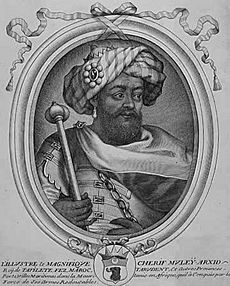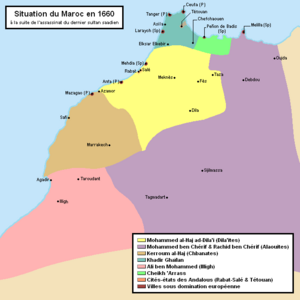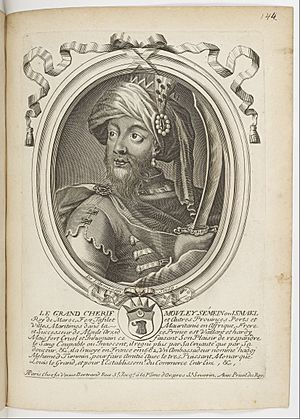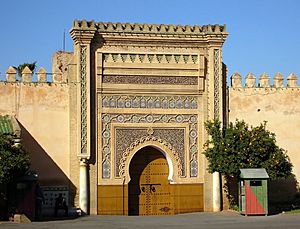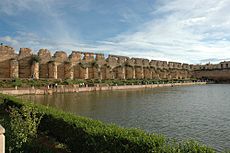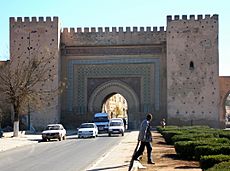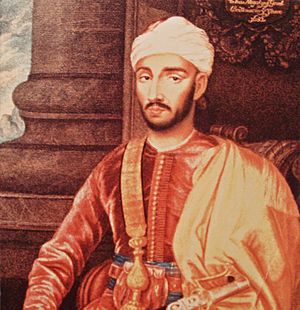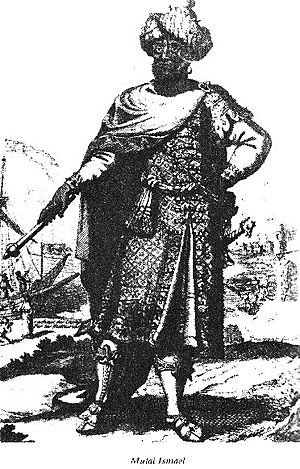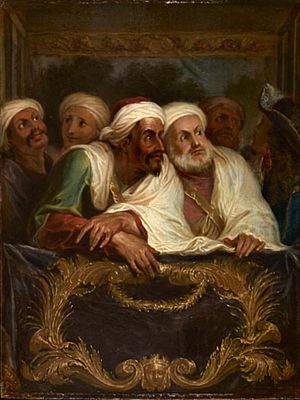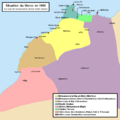Ismail Ibn Sharif facts for kids
Quick facts for kids Moulay Ismail Ibn Sharifمولاي إسماعيل بن الشريف |
|||||||||
|---|---|---|---|---|---|---|---|---|---|
| 2nd Ruler Alaouite dynasty | |||||||||
 |
|||||||||
| Sultan of Morocco | |||||||||
| Reign | 1672 – 1727 | ||||||||
| Coronation | 14 April 1672 | ||||||||
| Predecessor | Al-Rashid Ibn Sharif | ||||||||
| Successor | Abu'l Abbas Ahmad Ibn Ismail | ||||||||
| Governor of Fez | |||||||||
| Reign | 1667 – 1672 | ||||||||
| Born | c. 1645 Sijilmassa, Morocco |
||||||||
| Died | 22 March 1727 (aged 81–82) Meknes, Morocco |
||||||||
| Burial | March 1727 Mausoleum of Moulay Ismail, Meknes |
||||||||
| Spouse | among others: Khnata bent Bakkar Lalla Aisha Mubarka Halima Al Sufyaniyah Lalla Umm al-Iz at-Taba |
||||||||
| Issue | Moulay Mohammed Zeydan Moulay Ahmed Moulay Abdallah Amongst : 525 sons and 343 daughters |
||||||||
|
|||||||||
| House | 'Alawi dynasty | ||||||||
| Father | Sharif ibn Ali | ||||||||
| Religion | Sunni Islam | ||||||||
Moulay Ismail Ibn Sharif (Arabic: مولاي إسماعيل بن الشريف) was a powerful Sultan of Morocco. He was born around 1645 in Sijilmassa and passed away on March 22, 1727, in Meknes. He became the second ruler of the Alaouite dynasty in 1672 and reigned for 55 years, which is the longest rule of any Moroccan sultan.
Before becoming sultan, Moulay Ismail was the governor of Fez and northern Morocco from 1667. He took the throne after his half-brother, Sultan Moulay Rashid, died in 1672. Moulay Ismail was known for his strong leadership and for building a powerful army. He also had a very large family, with hundreds of children, making him one of the most well-known fathers in history.
During his long reign, Moulay Ismail helped Morocco become a strong country. He made Meknes his capital and built many impressive palaces and buildings there. He also worked to improve Morocco's relationships with other countries like France and Great Britain.
Contents
Moulay Ismail's Early Life and Rise to Power
Family Background and Birthplace
Moulay Ismail was born in 1645 in Sijilmassa. His father was Sharif ibn Ali, who was the first ruler of the Alaouite dynasty. His family believed they were descendants of the Islamic prophet Muhammad.
Morocco Before Ismail's Rule
Before Moulay Ismail became sultan, Morocco was going through a difficult time. After the Saadi dynasty ended, different leaders and groups fought for control. The country was divided into many smaller areas.
The Alaouite family, including Moulay Ismail's father, started to gain power in the region of Tafilalt. Moulay Ismail's father, Moulay Sharif, was the first Alaouite ruler. His older half-brother, Sidi Muhammad, then expanded their territory.
Becoming Sultan of Morocco
Moulay Ismail supported his half-brother, Moulay Rashid, who became Sultan after Sidi Muhammad. Moulay Rashid made Ismail the governor of Meknes and later the viceroy of Fez. This gave Ismail important military control in northern Morocco.
In 1672, Moulay Rashid died. Moulay Ismail quickly went to Fez, took control of the royal treasury, and declared himself Sultan of Morocco on April 14, 1672. He was 26 years old. Most of the people in Fez and surrounding areas pledged their loyalty to him. He chose Meknes as his new capital because of its good water supply and climate.
Challenges and Unifying the Empire
Early Rebellions and Conflicts
After becoming sultan, Moulay Ismail faced many challenges. His nephew, Moulay Ahmed ben Mehrez, also claimed the throne, leading to several battles. Other brothers and local leaders also rebelled against him.
Moulay Ismail quickly moved to put down these revolts. He defeated Ahmed ben Mehrez in Marrakesh and took control of the city. However, Ahmed continued to rebel for many years. Ismail also faced a challenge from Khadir Ghaïlan in the north, whom he defeated in 1673.
Bringing Peace to Morocco
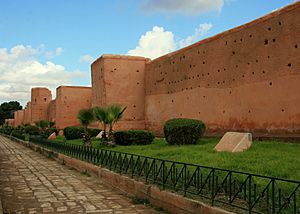
Moulay Ismail spent years fighting to unite Morocco. He had to deal with repeated revolts from his nephew Ahmed ben Mehrez, who often took control of Marrakesh. Ismail fought many battles, eventually forcing Ahmed to flee. After Ahmed's death in 1685, the main challenge to Ismail's rule ended.
He also put down rebellions by various tribes in the Atlas mountains. By 1693, Moulay Ismail had successfully brought all of Morocco under his control. He was the first Alaouite Sultan to achieve this complete unification. To maintain peace, he built many fortresses across the country.
Expelling European Powers
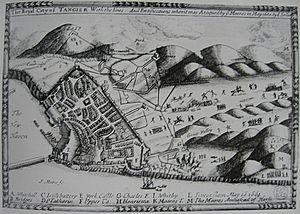
Moulay Ismail wanted to remove European control from Moroccan ports. He sent his army to recapture Tangier, which had been under English control. The English eventually left Tangier in 1684, and the Moroccan army took over.
He also captured La Mamora from the Spanish in 1681. Later, his army besieged and took Larache from the Spanish in 1689. In 1691, the Spanish also left Asilah, and Moroccan forces occupied it. These victories showed Moulay Ismail's strength and determination to control Morocco's coast.
Building a Strong Army and Capital
Creating a Professional Army
Moulay Ismail built a very strong army to keep control of his large empire. He created the Black Guard, also known as Abid al-Bukhari. These were loyal soldiers, many of whom were recruited from black slaves and free black men in Morocco. They were trained from a young age and were completely devoted to the Sultan. This army grew to a very large size, with tens of thousands of soldiers.
He also used other groups of soldiers, like the Jaysh al-Udaya, who were skilled camel riders. These military reforms made his central government much stronger and less reliant on tribal armies that might rebel.
Meknes: A Grand Capital City
Moulay Ismail chose Meknes as his capital city in 1672. He started a huge building project there, creating a magnificent palace complex. This complex included many grand residences, gardens, impressive gates, and mosques. He even brought marble and other materials from older palaces and Roman ruins to build his new city.
He built the Heri es-Swani, a massive storehouse for food, and the Agdal Reservoir to ensure a steady water supply for the city's gardens. He also built prisons and many other public buildings. Construction continued throughout his entire reign, making Meknes a truly grand capital.
Diplomacy and Foreign Relations
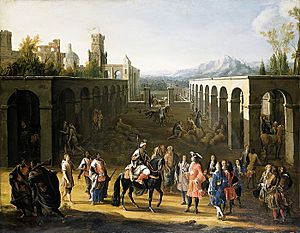
Moulay Ismail worked to establish good relationships with other countries, especially France and Great Britain. These relationships often involved trade and discussions about releasing European captives. He sometimes sought help from France in his wars against Spain.
He sent ambassadors to France and Great Britain to negotiate treaties. For example, Mohammad Temim was sent to France in 1682 and signed a friendship treaty. Abdelkader Perez was sent to Britain in 1723. These diplomatic efforts helped Morocco maintain its position on the world stage.
Later Reign and Legacy
Challenges in Later Years
The later part of Moulay Ismail's reign saw some military setbacks and family issues. He had conflicts with Ottoman Algeria over borders, including the Battle of Moulouya in 1692. He also tried to capture Ceuta from the Spanish for many years, but it remained under Spanish control until his death.
Moulay Ismail divided some provinces among his many sons. This led to rivalries and conflicts between them. He had to deal with several rebellions from his sons, which caused instability. He eventually chose Moulay Ahmed as his successor.
Death and Succession
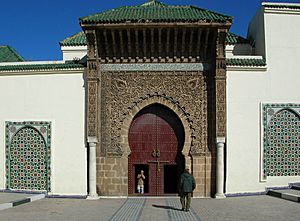
Moulay Ismail Ibn Sharif passed away on March 22, 1727, at the age of 81. His reign of 55 years was the longest of any Moroccan monarch. He was buried in his mausoleum in Meknes.
After his death, Morocco faced a period of civil war as his sons fought for the throne. Several different sultans ruled in the years that followed. However, Moulay Ismail's reign is remembered as a time when Morocco was unified, secure, and powerful. He left behind a strong army and a magnificent capital city in Meknes.
Character and Personality
Moulay Ismail was known for his strong will and determination. He was a very powerful leader who wanted to bring order and authority to his country. He was also a skilled horseman and was known for his physical strength and cleverness, even when he was older.
Europeans at the time described him as a very strict ruler. He was also a devout follower of his religion, Islam. He was known to debate religious topics and practiced his faith with great care.
Marriages and Children
Moulay Ismail had many wives and concubines throughout his life. His first recorded marriage was in 1670. Some of his notable wives included Lalla Aisha Mubarka and Lalla Khanatha bint Bakkar. Lalla Aisha Mubarka was very influential and was sometimes called the "Empress of Morocco" by Europeans, though this title wasn't used in Muslim courts.
Moulay Ismail is famous for having a very large number of children. Records from 1703 show he had 868 children (525 sons and 343 daughters). By the time of his death, he had well over a thousand children, making him one of the people with the most children in recorded history.
Images for kids
See also
 In Spanish: Ismaíl de Marruecos para niños
In Spanish: Ismaíl de Marruecos para niños
- Khnata bent Bakkar
- Alaouite
- History of North Africa
- History of Morocco
- Anglo-Moroccan alliance
- List of people with the most children



